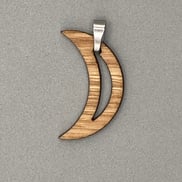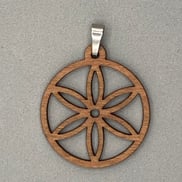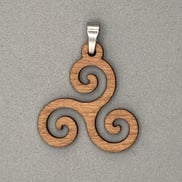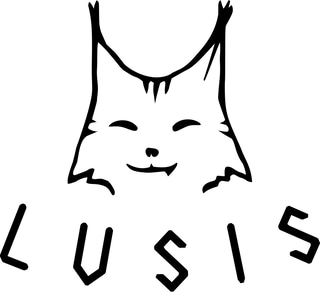Spiritual


Ichthys
The Ichthys symbol, also known as the Christian fish symbol, is a simple but powerful emblem representing Christianity. The symbol consists of two intersecting arcs that form the shape of a fish. It derives from the Greek word ichthys (ἰχθύς), which means "fish" and is an acronym for the phrase Iēsous Christos, Theou Yios, Sōtēr (Ἰησοῦς Χριστὸς, Θεοῦ Υἱὸς, Σωτήρ), meaning "Jesus Christ, Son of God, Savior." In early Christianity, the Ichthys symbol was used as a secret sign among Christians during times of persecution in the Roman Empire. It was a discreet way for believers to identify one another without drawing attention. The fish also has significant biblical symbolism. In the New Testament, Jesus performed miracles involving fish, and he called his disciples "fishers of men," symbolizing their role in spreading the gospel. Today, the Ichthys is widely recognized as a symbol of Christian faith and is often displayed on jewelry, car decals, and church decorations. It represents the belief in Jesus as the Savior and reflects key Christian teachings of salvation, discipleship, and divine protection.


Lotus
In Hindu culture, the lotus holds deep symbolic significance and is revered as a sacred flower. It represents purity, spiritual enlightenment, and divine beauty. Despite growing in muddy waters, the lotus remains unstained, symbolizing the ability of the soul to rise above worldly attachments and material desires. This quality makes it a powerful metaphor for spiritual growth and the journey toward liberation (moksha). The lotus is often associated with several Hindu deities. Goddess Lakshmi, the goddess of wealth and prosperity, is frequently depicted seated on a blooming lotus, signifying spiritual and material abundance. Lord Vishnu, the preserver of the universe, is also shown holding a lotus, emphasizing order, balance, and life-giving energy. Similarly, Lord Brahma, the creator, is believed to have emerged from a lotus that sprouted from Vishnu’s navel, symbolizing creation and the unfolding of the universe. In Hindu scriptures, the lotus is also linked to chakras, particularly the crown chakra (Sahasrara), which represents supreme consciousness. Overall, the lotus embodies detachment, inner strength, and the eternal pursuit of truth.


Moon
The moon crescent is a powerful and ancient symbol that holds varied meanings across cultures and religions. Often associated with femininity, cycles, and change due to the moon’s phases, the crescent is especially tied to spiritual and temporal rhythms. In Islamic culture, the crescent moon (often paired with a star) is a prominent symbol representing faith and divine guidance. Though not originating from early Islamic teachings, it was adopted by the Ottoman Empire and later became associated with Islam globally. It is used today on many national flags of Muslim-majority countries. In ancient Mesopotamia, the crescent moon represented the moon god Sin (or Nanna), who governed time and wisdom. Similarly, in Greek and Roman mythology, the crescent is associated with the moon goddesses Artemis and Diana, symbols of purity, the hunt, and protection. In Hinduism, the crescent moon adorns the head of Lord Shiva, symbolizing the cycle of time and his dominion over it. It also reflects the idea of balance between destruction and renewal, as the moon wanes and waxes. In Pagan and Wiccan traditions, the crescent moon is sacred, representing the Goddess or feminine divine. It is part of the triple moon symbol: waxing crescent (maiden), full moon (mother), and waning crescent (crone), embodying the stages of womanhood and life's natural cycles. Across these traditions, the crescent moon generally conveys transformation, protection, divine presence, and femininity. Despite its varied interpretations, the recurring themes of change, spirituality, and the cosmos give the crescent a unifying symbolic power across cultures.


Germ of Life
The Germ of Life is a powerful symbol representing the origin or seed of existence, potential, and creation. Often used metaphorically, it refers to the smallest unit or beginning from which life or significant growth can emerge. In biological terms, a germ is the initial cell or organism that eventually develops into a complex life form. Symbolically, it embodies the idea of latent potential—the spark that contains within it the blueprint for full realization. Across cultures and philosophies, the Germ of Life is associated with birth, rebirth, and the cyclical nature of existence. In spiritual or mystical contexts, it may signify divine creation or the soul's journey from its pure origin toward fulfillment. Artists and writers often use the term to explore themes of inspiration, transformation, and the mysterious force that animates living beings. The symbol encourages a reverence for beginnings—however small—and a recognition that great things often arise from seemingly insignificant origins. It also carries hope, implying that even in darkness or dormancy, life and growth are possible, waiting for the right conditions to flourish.


Snake
In Old European Stone Age cultures, particularly during the Neolithic period (circa 7000–3000 BCE), the snake was a potent and sacred symbol deeply linked to fertility, transformation, and the cycles of nature. Archaeological findings, especially from the Danube and Balkan regions, reveal snake imagery on pottery, figurines, and temple artifacts, often associated with the Mother Goddess—a central figure in early agrarian religions. The snake's ability to shed its skin made it a natural symbol of renewal and rebirth, aligning with the seasonal cycles crucial to early farming communities. Its close connection to the earth and underground burrows also linked it to chthonic (underworld) powers and the mysteries of life, death, and regeneration. Snakes were seen as guardians of sacred places and symbols of the life force inherent in the soil and human fertility. In this context, they often appeared alongside goddess figures, emphasizing their role in female-centered spirituality and the continuity of life. Rather than being feared, the snake was revered as a life-giver, healer, and protector. This symbolic legacy persisted through later mythologies and religions, influencing how snakes were perceived in Indo-European, Mediterranean, and pagan traditions that followed. In ancient Egypt, the snake was both feared and revered. The cobra, especially, symbolized royal power and divine protection. The uraeus, a rearing cobra on pharaohs’ crowns, represented the goddess Wadjet, protector of Lower Egypt. At the same time, serpents were linked to chaos and the underworld. In Hinduism, snakes (or nagas) are sacred and often associated with water, fertility, and the earth’s life force. The god Vishnu rests on a serpent, Ananta, symbolizing eternity and the cosmic cycle. Shiva wears a cobra around his neck, representing mastery over death and time. In Greek mythology, snakes are often symbols of transformation and healing. The rod of Asclepius, a serpent-entwined staff, remains a symbol of medicine today. Conversely, the snake-haired Medusa embodied danger and petrifying power. In Christianity, the snake is most commonly associated with temptation and sin, particularly in the story of Adam and Eve. This gave the serpent a largely negative connotation in Western tradition, symbolizing deceit and evil. Despite cultural differences, the snake universally embodies duality: it can heal or harm, create or destroy, and signify both the material and spiritual worlds. Its recurring association with cycles, transformation, and hidden wisdom makes it one of the most enduring and multifaceted symbols in human history.


Triskeles
The Triskele, also known as the Triskelion, is a prominent symbol in Celtic culture consisting of three interlocking spirals or curved legs radiating from a central point. Found in ancient Celtic art, especially in Ireland, Brittany, and Scotland, the Triskele dates back to the Neolithic and Bronze Ages, but it became especially significant in Celtic spirituality. The number three held deep meaning for the Celts, symbolizing balance, motion, and the interconnectedness of life. The Triskele is thought to represent various triplicities important in Celtic belief, such as land, sea, and sky; birth, death, and rebirth; or mind, body, and spirit. The spirals’ motion suggests eternal movement and growth, reflecting the natural cycles of the world and spiritual evolution. In some interpretations, the Triskele is linked to solar energy, female power, or the triple goddess—maiden, mother, and crone—representing stages of life. It was often carved on stones, jewelry, weapons, and sacred sites. Today, the Triskele remains a powerful symbol of Celtic identity and spirituality, embraced in modern paganism, art, and tattoo culture. It continues to represent harmony, cycles, and the sacred power of threes in life and nature.
